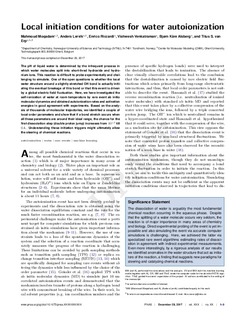| dc.contributor.author | Moqadam, Mahmoud | |
| dc.contributor.author | Lervik, Anders | |
| dc.contributor.author | Riccardi, Enrico | |
| dc.contributor.author | Venkatraman, Vishwesh | |
| dc.contributor.author | Alsberg, Bjørn Kåre | |
| dc.contributor.author | van Erp, Titus Sebastiaan | |
| dc.date.accessioned | 2019-04-10T09:28:53Z | |
| dc.date.available | 2019-04-10T09:28:53Z | |
| dc.date.created | 2018-12-12T19:58:54Z | |
| dc.date.issued | 2018 | |
| dc.identifier.citation | Proceedings of the National Academy of Sciences of the United States of America. 2018, 115 (20), E4569-E4576. | nb_NO |
| dc.identifier.issn | 0027-8424 | |
| dc.identifier.uri | http://hdl.handle.net/11250/2593998 | |
| dc.description.abstract | The pH of liquid water is determined by the infrequent process in which water molecules split into short-lived hydroxide and hydronium ions. This reaction is difficult to probe experimentally and challenging to simulate. One of the open questions is whether the local water structure around a slightly stretched OH bond is actually initiating the eventual breakage of this bond or whether this event is driven by a global ordering that involves many water molecules far away from the reaction center. Here, we investigated the self-ionization of water at room temperature by rare-event ab initio molecular dynamics and obtained autoionization rates and activation energies in good agreement with experiments. Based on the analysis of thousands of molecular trajectories, we identified a couple of local order parameters and show that if a bond stretch occurs when all these parameters are around their ideal range, the chance for the first dissociation step (double-proton jump) increases from 10−7 to 0.4. Understanding these initiation triggers might ultimately allow the steering of chemical reactions. | nb_NO |
| dc.language.iso | eng | nb_NO |
| dc.publisher | National Academy of Sciences | nb_NO |
| dc.title | Local initiation conditions for water autoionization | nb_NO |
| dc.type | Journal article | nb_NO |
| dc.type | Peer reviewed | nb_NO |
| dc.description.version | acceptedVersion | nb_NO |
| dc.source.pagenumber | E4569-E4576 | nb_NO |
| dc.source.volume | 115 | nb_NO |
| dc.source.journal | Proceedings of the National Academy of Sciences of the United States of America | nb_NO |
| dc.source.issue | 20 | nb_NO |
| dc.identifier.doi | 10.1073/pnas.1714070115 | |
| dc.identifier.cristin | 1642419 | |
| dc.description.localcode | © 2018. This is the authors' accepted and refereed manuscript to the article. The final authenticated version is available online at: https://doi.org/10.1073/pnas.1714070115 | nb_NO |
| cristin.unitcode | 194,66,25,0 | |
| cristin.unitname | Institutt for kjemi | |
| cristin.ispublished | true | |
| cristin.fulltext | postprint | |
| cristin.qualitycode | 2 | |
